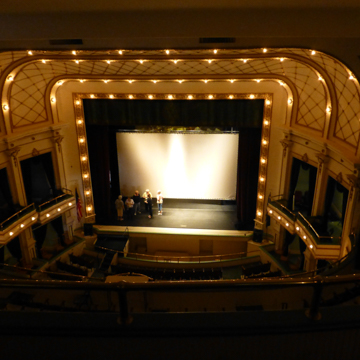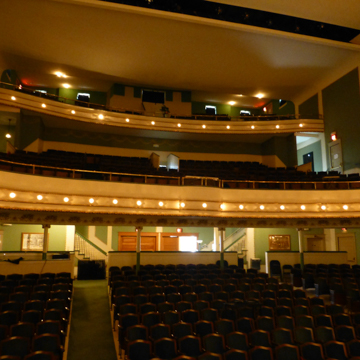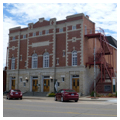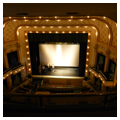You are here
Brown Grand Theatre
As with many early Kansas towns starved for entertainment, Concordia was quick to build a venue that could accommodate troupes of traveling entertainers. Unfortunately, Concordia’s first opera house burned in 1895 and the community was unable to raise the funds to replace it. In March 1906, “Colonel” Napoleon Bonaparte Brown, a wealthy resident who had come to Concordia in 1876 to operate a banking business, hired architect Carl Boller to design a new theater.
Boller was one of ten children of German immigrants who had settled in St. Joseph, Missouri. He worked as a scene painter for vaudeville groups and gained firsthand knowledge of many theaters in the region. At the time of the Concordia commission, Boller had just opened an architectural practice in Kansas City. He was joined by his youngest brother, Robert Otto Boller, who served as a draftsman. The Boller brothers built a large and successful theater design practice, creating designs throughout the country, including eleven in Kansas.
By May 1906, the plans for the opera house were complete but no construction bids were received. Undeterred, Brown decided to build the theater himself. His son Earl acted as the director, and Brown hired W. T. Short as the construction supervisor. The Emery Byrd Thayer Company of Kansas City served as consultant on interior finishes and furnishings. The building opened in September 1907. Located on the southern side of Sixth Street, Concordia’s main commercial street, the front of the building features a well-composed Renaissance Revival facade made of rough-hewn local limestone on the lower level, with locally fired brick and Cottonwood limestone trim above. The other sides of the building are more utilitarian.
The Browns operated the theater and brought in a steady stream of high quality performances. Unfortunately, both father and son died within a few years of the venue’s opening. Their widows donated the building to the City of Concordia, but after trying to run the theater for five years, the City gave the building back to the Brown estate. Ray Green, who had married Earl Brown’s widow, operated the theater successfully for almost ten years before selling it to the Concordia Amusement Company, which operated the building as a movie theater.
In 1973 the City acquired the building and a group of citizens formed the Brown Grand Opera House, Inc. with the intent to raise money to rehabilitate the theater so that it could once again accommodate live shows. By 1980 the renovation was complete, and the building reopened as a venue for live performances. The only visible evidence of the restoration is metal exterior egress stairs attached to the sides of the building.
After operating as a movie theater for almost twenty-five years, the interior of the building required extensive restoration. The public spaces received new finishes to match the original material and detail. Furnishings, including theater seating, were replaced with antique pieces as close as possible to the original items. The main hall is relatively tall, containing two balconies. It originally seated 1,000 people, but because the upper balcony is now furnished with theater seating rather than the original wooden benches, the room accommodates 650 people. The stage and backstage spaces were returned to their original function. The theater now features a regular schedule of shows, is open for tours, and can be rented by community groups. The Brown Grand Theater, as it is now known, is once again a valuable cultural resource for Concordia and surrounding communities.
NOTE: This entry was originally published in David Sachs and George Ehrlich, Guide to Kansas Architecture (Lawrence: University Press of Kansas, 1996). © 1996 by the University Press of Kansas.
References
Pankratz, Richard, “Brown Grand Opera House,” Cloud County, Kansas. National Register of Historic Places Inventory-Nomination Form, 1973. National Park Service, U.S. Department of the Interior, Washington, D.C.
Writing Credits
If SAH Archipedia has been useful to you, please consider supporting it.
SAH Archipedia tells the story of the United States through its buildings, landscapes, and cities. This freely available resource empowers the public with authoritative knowledge that deepens their understanding and appreciation of the built environment. But the Society of Architectural Historians, which created SAH Archipedia with University of Virginia Press, needs your support to maintain the high-caliber research, writing, photography, cartography, editing, design, and programming that make SAH Archipedia a trusted online resource available to all who value the history of place, heritage tourism, and learning.



















